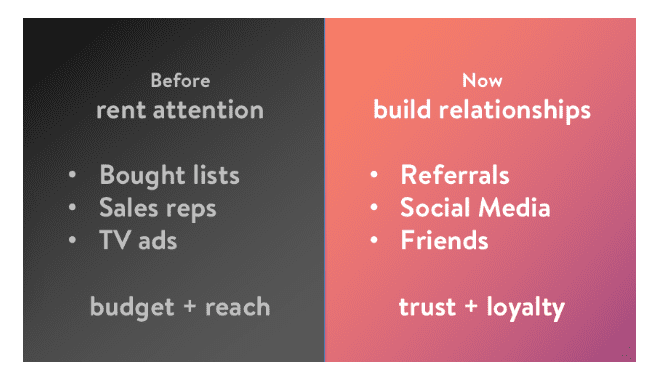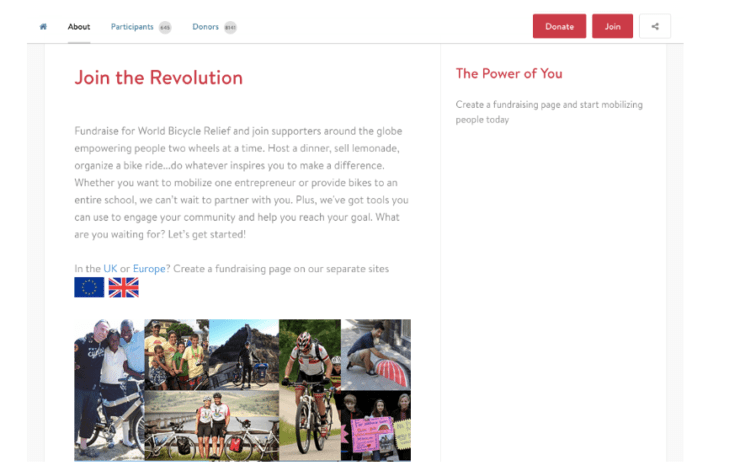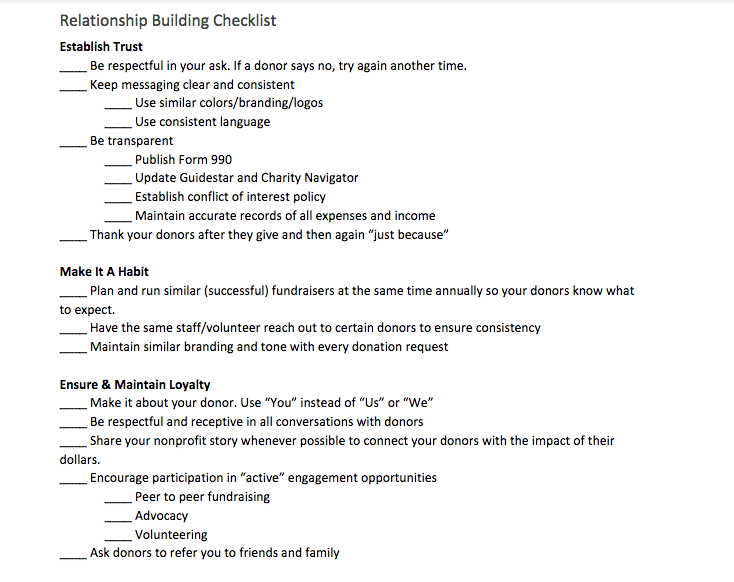As a fundraiser, you wear many hats. You plan, you market, you sell. You collect money, manage volunteers and organize activities year-round. And your role is constantly evolving because the needs of your organization and the scope of your resources can vary year to year and sometimes even month to month.
Through all the normal ebbs and flows, highs and lows, busy times and not-so-busy times of fundraising, one thing remains constant: your responsibility to bring money (and thus, donors) in the door.
The Need: Donor Retention
But, how do we keep individual contributions consistent or growing year over year, making our jobs easier (and more secure)? The answer is donor retention!
“How do we keep contributions consistent or growing year over year? The answer is donor retention!” tweet this
Studies like the Association of Fundraising Professional’s Fundraising Effectiveness Project have shown us that donor retention rates increase compared to the number of gifts a donor makes. Therefore, it’s safe to assume that you’ll hold onto donors making second or subsequent gifts at higher rates than first-time donors.
Download a free copy of our Donor Engagement & Retention Playbook:
You may have even seen a number of the blog posts and resource guides our CauseVox team has compiled around the subject over the years. We focus on retention because we see these gifts as “money in the bag” for your cause.
And while there is no sure-fire way to guarantee 100% donor retention or even to ensure every donor is happy, there is one underlying component to every tip and strategy we’ve offered over the years: relationships.
The Strategy: Relationship Building

To retain your donors, we believe you must prioritize building quality, genuine, two-way relationships with your donors. These relationships aren’t just about what your donor does for your organization (read: hand you money), but what you do for your donor
“To retain your donors, we believe you must prioritize building quality, genuine, two-way relationships.” tweet this
To begin wrapping our heads around this idea, let’s think back to how we used to “engage” with donors.
The Past
Fundraising methods have changed over the years and many strategies we used in the past aren’t as effective today as they were before.
Do you remember collecting names from real estate records and making cold calls? Maybe you put a weekly ad in the local paper to promote your capital campaign or mailed some pledge cards out to prospective donors. It’s possible you recently ramped up your website’s SEO and even put some money into Google and Facebook ads.
After all, it’s important to be seen and heard, and that’s what these strategies helped with. You got in front of a lot of people, which is exactly what you wanted to do.
But, guess what? Everyone else has the same idea. It’s a hard truth to swallow, but it’s one all of us in the nonprofit sector need to face. Our nonprofit or charity is putting out promoted Instagram posts, but so is XYZ organization. We’re all paying for attention.
With so much information, stories, and “asks” passing by our donors every day, how can you differentiate yourself from the pack?
The answer is relationship building.
The Future
In today’s fast-paced, noisy, and connected world, what sets you apart from others isn’t your aggressive marketing, Google ads, promoted Facebook posts, or perfectly timed fundraising emails. No, it’s the relationships you form with donors that make you memorable, relevant and keep your donors coming back time after time.
Similar to any sort of partnership, the donor to nonprofit relationship is built on a foundation of trust, habit, and loyalty.
“The donor to nonprofit relationship is built on a foundation of trust, habit, and loyalty.” tweet this
1. Trust
trust: firm belief in the reliability, truth, ability, or strength of someone or something.
You trust your hairdresser to cut your hair without nicking your ear. You trust the dry cleaner to take good care of your cashmere sweater. As consumers, we trust companies to give us safe products and services that improve our lives. We do this because, as humans, we’re hardwired to want to trust. Not surprisingly, trust makes us happier and less stressed.
Trust lies at the core of all our relationships. It’s the currency of influence in every workplace and organization.– Margie Warrell
Ultimately, your relationship with donors is built on trust. Your donors deserve to give to a transparent, effective organization. To cultivate, build, and sustain donor trust, focus on the following:
- Avoid “pushy” asks. Do not guilt or force donors to make a gift. Be respectful when a donor says that it’s not the right time.
- Keep all messaging (website, emails, social media posts, direct mail, ads) clear and consistent. This doesn’t mean you should just copy and paste your mission statement or slogan and leave it at that. Instead, build on your mission statement and relate it to segments of your donor population. Use similar “action verbs”. For example, United Way encourages supporters to “Give, Advocate, and Volunteer”. Then, the organization builds of this call to action by offering opportunities to engage catered to the intended audience.
- Practice transparency. Here are a few ways to prove your organization is transparent:
- Keep your Guidestar and Charity Navigator profiles current and accurate
- Upload your Form 990 to your website
- Include a conflict of interest policy in your board manual
- Maintain accurate records of all expenses, including supplies, marketing costs, travel and per diem
- Share your results often and effectively. We suggest you prepare an annual report that includes statistics and stories covering donors, gifts, and overall impact. If possible, calculate a donor’s return on investment (ROI) and share this as well.
- Thank your donors immediately after they donate. The more personal the outreach, the better. If you have time to write a handwritten thank you, then, by all means, do so. You can also pick up the phone and give your donors a call or even shoot them an email that says you received the gift and are so grateful for their continued support.
Establishing and then maintaining trust is the first step toward building relationships with your donors.
2. Habit
habit: a settled or regular tendency or practice, especially one that is hard to give up.
When we talk about habits, we tend to focus on the ones that are “bad.” You know what I’m talking about—letting out the occasional swear word, eating fast food, watching a Keeping Up With the Kardashians marathon. We’re all guilty of them!
But some habits are good and actually beneficial for both your donor and your cause. So, if you find your donor connecting with you online or even making gifts in a seemingly automatic or regular way, then you’re on your way to a stronger relationship, and thus, a retained donor.
When all’s said and done, you want donors to connect out of habit.
In fact, humans are supposed to respond to habits because it’s just a form of automation. Per the Harvard Business Review, research into the workings of the human brain suggests that the mind loves automaticity more than just about anything else—certainly more than engaging in conscious consideration.
There are quite a few ways that you can make giving and connecting a habit for your donors, including:
- Running similar fundraisers (proven successful) at the same time year after year. For example, if you know your donors love donating and sharing your cause on #GivingTuesday, then keep this momentum going annually.
- Try to have the same staff person or volunteer connect with donors. Yes, it is brutally hard to tackle turnover in nonprofits, but consistency can definitely help to minimize confusion or questions when it comes time for the next ask.
- Keep branding and tone consistent, whether you’re sharing a story on Facebook or sending out a fundraising email. If your brand is appealing and recognizable to donors, don’t change it unless absolutely necessary.
When donors come to you out of habit, that means you’ve earned their trust. They no longer have to “think” or consider giving, they just need to be asked.
3. Loyalty
loyalty: a strong feeling of support or allegiance
Loyalty is another part of the foundation of a strong relationship between a donor and nonprofit.
Donors may choose to give because they trust you, or automatically give out of habit because they’ve done so before. But when donors seek you out and connect because they wholeheartedly believe in your cause, they’ve moved past being passive participants in the process. Instead, they’re active, engaged, and ready to rally.
“When customers have an emotional connection with your brand, they’ll make an effort to get it.”
But loyalty doesn’t happen overnight and it doesn’t necessarily happen after a year. It takes nurturing.
Here are some ways to cultivate donor loyalty:
- Promote your shared values, but make them about your donor. Always! In the end, each donation is about making your donor feel good. They’re giving to help your cause. They’re the people responsible for making the impact happen.
- Respond promptly and honestly to your donors. When supporters reach out to you, whether to pay you a compliment, offer suggestions, or because of an issue—communicate appropriately and with respect. Donors expect and deserve to be heard.
- Give them something to care about by telling your nonprofit story. Share videos and images of work in the field. Tell stories about clients helped by donor donors. Prove to your donors that their gift doesn’t just matter, it’s vital.
Once a donor starts inquiring about the next fundraiser or asks how they can get involved, then you know they’ve become loyal to your cause. And here is where the fun begins because you know this donor is now ready to not just give, but participate in the process.

To maintain loyalty and further cultivate your relationship, incorporate aspects of People Fundraising. With People Fundraising, you aren’t just asking for donations, you’re actively rallying donors behind your cause. Try one or more of these tactics:
- Activate donors with engagement opportunities.
- We think that peer-to-peer fundraising is the bee’s knees. It’s the perfect way for donors to put a bit of effort (and heart) into supporting your cause, while also expanding your audience of prospective donors.
- Offer activities that allow donors to advocate for your cause, such as signing a petition or participating in a march.
- Gather volunteers to help support your programming.
- Ask donors to refer you to friends and family or share your campaign. To make it easy, add social sharing buttons to your fundraising website and create social media content worth sharing.
When you have a loyal donor, you’re not just receiving the occasional donation. You’re getting a cheerleader, a volunteer, a constructive critic, a personal fundraiser—a true friend to your cause.
Now more than ever, it’s time to step away from those transactional, one-sided requests. You know the one’s we’re talking about: “We are asking you to give $50” “Please help us reach our goal by making a donation”
Instead, focus on building trust, loyalty, and habit with donors so that down the road they don’t just want to hand you a check, but instead become volunteers, advocates, fundraisers—active participants in your cause.
“Focus on building trust, loyalty, and habit with donors…” tweet this

Remember, just like friendships, connections with donors don’t form overnight. They’re a process. But after you’ve put in the time, proven your worth, earned trust, gotten into a rhythm, and established loyalty, you’re on your way to a long, fruitful, active, and fulfilling relationship.
Editor's Picks
Ultimate Guide To Peer-to-Peer Fundraising
Customer Story: Spur Local Raises Over $1M With Their Give Local Campaign
Fundraising Strategies for Nonprofits: Craft the Best Approach for Your Organization
Create a Killer Fundraising Plan - Best Practices, Strategies, & Downloadable Template



